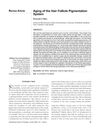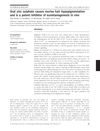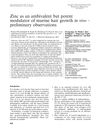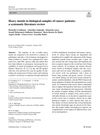TLDR Heavy metals can damage skin and hair in mice.
The study investigated the effects of heavy metal salts (nickel, chromium, lead, and zinc) on the skin and its derivatives in C57BL/6 mice. It was found that subacute intoxication with nickel, chromium, and lead caused dystrophic changes in hair follicles, such as melanin granule ectopia and enlarged hair channels, without altering the anagen stage duration. Nickel and lead exposure led to mononuclear infiltration in the dermis and hypodermis, while lead acetate caused capillary congestion and dermal infiltration by siderophages. Immunohistochemical analysis showed increased keratinocyte proliferative activity with zinc sulphate and sodium dichromate, but decreased activity with lead acetate.
 75 citations
,
January 2009 in “International journal of trichology”
75 citations
,
January 2009 in “International journal of trichology” Hair grays due to oxidative stress and fewer functioning melanocytes.
 30 citations
,
June 2006 in “British journal of dermatology/British journal of dermatology, Supplement”
30 citations
,
June 2006 in “British journal of dermatology/British journal of dermatology, Supplement” Oral zinc sulphate reduces dark hair color in mice.
 60 citations
,
October 2005 in “Experimental Dermatology”
60 citations
,
October 2005 in “Experimental Dermatology” Zinc can both inhibit and stimulate mouse hair growth, and might help recover hair after chemotherapy.
 36 citations
,
April 1994 in “PubMed”
36 citations
,
April 1994 in “PubMed” Cyclosporine A slows down hair loss from chemotherapy in mice, while dexamethasone increases hair loss but speeds up regrowth.
 2 citations
,
September 2019 in “South Asian research journal of pharmaceutical sciences”
2 citations
,
September 2019 in “South Asian research journal of pharmaceutical sciences” Heavy metals in personal care products can cause serious health issues like cancer and hair loss.
13 citations
,
April 2019 in “International journal of molecular sciences” Acyzol could help treat conditions caused by zinc deficiency.
 47 citations
,
May 2012 in “Applied Water Science”
47 citations
,
May 2012 in “Applied Water Science” Removing trace elements from drinking water is essential for human safety.
 February 2024 in “BioMetals”
February 2024 in “BioMetals” Heavy metals like arsenic, cadmium, and lead can increase cancer risk and worsen outcomes.

Polarized microscopy helps identify hair irregularities in genetic disorders.







